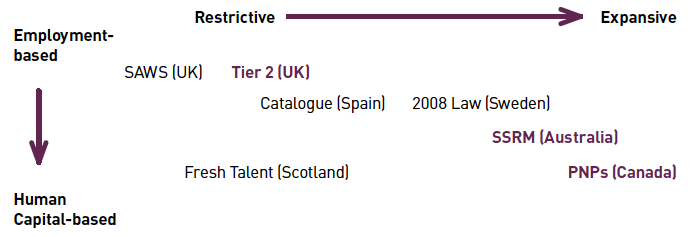Migration: helping Scotland prosper
Paper detailing how a tailored migration policy, within a UK framework, could operate to meet Scotland's distinct needs.
Glossary
Selection Criteria Of Immigration Programmes
The Expert Advisory Group on Migration and Population developed a matrix to describe different approaches to the selection criteria of immigration programmes. Immigration programmes may select potential migrants based on specific job vacancies or shortage (employment based); or they may select based on the characteristics of those being admitted (human capital based). A points-based system would typically look at human capital characteristics, although some schemes can combine features of both employer-based and human capital-based programmes.
Employment-based programmes encompass both sectoral schemes, which select migrants based on their fit to shortage occupations, as well as employer-led schemes, which rely on employers to identify workers to fill vacancies. In both cases, migrants typically need a job offer before being admitted.
Human capital based programmes select migrants based on their characteristics, such as age and family status, skills and experience, or prior links with the destination country. Such programmes often take the form of points-based systems, which give different weight to such characteristics. They may prioritise migrants with particular skills or qualifications, in order to address sectoral/occupational shortages, or they may prioritise migrants with a link to a particular local area, in order to encourage settlement.
The Expert Advisory Group also distinguished programmes in terms of their package of rights and pathways to settlement. Restrictive programmes are associated with temporary stay and limited rights to family reunion, welfare and social benefits, or access to public services. Expansive programmes build in more generous rights and pathways to permanent residency, often from the outset.
The Group categorised the main route in the current UK immigration system, Tier 2, as a restrictive employment-based system. The Scottish Government proposal for a Scottish Visa describes an expansive human capital based system, similar to the regional programmes in Canada and Australia.
Human capital-based programmes with expansive rights (such as the Canadian Provincial Nominee Programs and the Australian State Specific and Regional Migration schemes) may be designed to expand the working-age population, meet sectoral shortages, or alleviate population shortages in particular areas. Migrants may be selected through points-based systems that prioritise based on demographic features, and may also build in preference for particular skills or qualifications.
Figure 18: Mapping selection criteria of immigration programmes

Note On Terminology
This paper uses the term ‘migrant’. When discussing the flow of migration, this refers to a person not currently resident in Scotland who moves to Scotland with the intention of remaining here for more than 12 months.
The term migrant may therefore refer to:
- UK nationals if they are resident elsewhere (in the UK or abroad) and move to Scotland, and would be counted in migration flows. When talking about the population of migrants in Scotland, this normally refers only to non-UK nationals, split between EU and other international migration.
- Irish nationals have rights within the Common Travel Area to live and work in the UK that are separate from their right to free movement as EU citizens. As they are EU citizens, this paper refers to Irish nationals within the flow of migration from the EU and within the population of EU migrants in Scotland.
- EU citizens, EEA nationals and Swiss nationals who have rights under treaties and directives governing the European Single Market and free movement of people to live and work in other EU Member States, countries within the EEA and Switzerland. This paper normally refers to EU citizens and EU migration rather than EEA, unless greater clarity is required, as the number of EEA nationals and Swiss nationals in Scotland is low.
- International migrants from other countries. Most international migrants in Scotland are issued with a visa under one of the tiers of the UK immigration system. The other main route for international migrants is family migration. A small proportion of international migrants in Scotland entered by seeking asylum and there are particular humanitarian obligations in relation to refugees and asylum seekers.
Countries in the EU are sometimes grouped according to how long they have been a Member State. Terms used in this paper include:
- EU14, meaning the 14 other Member States (excluding the UK) prior to the 2004 enlargement. These are Austria, Belgium, Denmark, Finland, France, Germany, Greece, Ireland, Italy, Luxembourg, Netherlands, Portugal, Spain and Sweden.
- EU8, meaning the eastern and central European countries that joined the EU in the 2004 enlargement. These are Czech Republic, Estonia, Hungary, Latvia, Lithuania, Poland, Slovakia and Slovenia.
- EU2, meaning Bulgaria and Romania, countries that joined the EU in 2007.
- EU Other, meaning Cyprus and Malta (joined in 2004), and Croatia (joined in 2013).
The current system for international migration was first introduced in the UK in 2008 and consists of five tiers, each of which can contain multiple categories of visa. Tier 1 is for high value and exceptional talent, including entrepreneurs and investors. Tier 2 is for skilled workers sponsored by an employer. Tier 3 is for low‑skilled workers, but has never been implemented. Tier 4 is for students, and Tier 5 is for temporary workers, including youth mobility entrants and the new Seasonal Workers Pilot Scheme.
Contact
Email: Migration@gov.scot
There is a problem
Thanks for your feedback